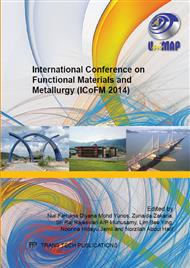p.123
p.129
p.134
p.140
p.146
p.155
p.161
p.167
p.173
Effect of Corn Starch and Potato Starch as the Pore Forming Agent to the Structure of Porous Cordierite
Abstract:
Porous cordierite is an advanced ceramic which is popular for its interesting properties such as excellent thermal stability, high refractoriness and low dielectric constant. In this study, samples have been prepared by the mixture of aluminium nitrate nonahydrate, magnesium nitrate hexahydrate, tetraethylorthosilicate (TEOS), ethanol and nitric acid through sol-gel route. Corn and potato starch were used as pore forming agent. The amount of pore forming agent added was varied according to their weight percent (5wt%, 10wt%, 15wt% and 20wt%). The solution was then dried in oven at 90°C before sintered at 1350°C. Particle size analyzer was used to characterize the properties of pore forming agents. Scanning electron microscopy (SEM) and X-ray diffraction (XRD) analysis were done on the produced samples. XRD results proved that all the samples produced were pure α-cordierite without the presence of other impurity or pore forming agent. From SEM results, samples using potato starch as the pore forming agent have pore size larger than corn starch due to the larger particle size of potato starch. Majority of the samples show interconnectivity among pores. The pore shape produced by potato starch is in prolate shape whereas for corn starch is in polyhedral shape.
Info:
Periodical:
Pages:
146-151
Citation:
Online since:
June 2015
Authors:
Keywords:
Price:
Сopyright:
© 2015 Trans Tech Publications Ltd. All Rights Reserved
Share:
Citation:


